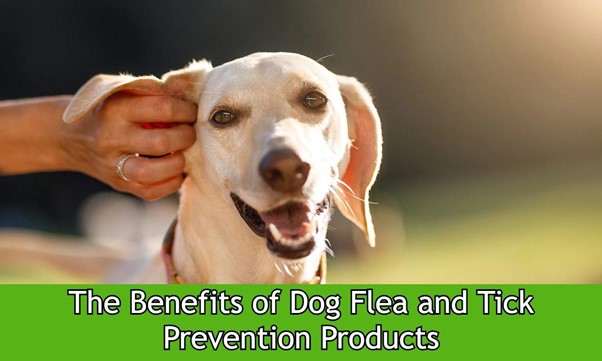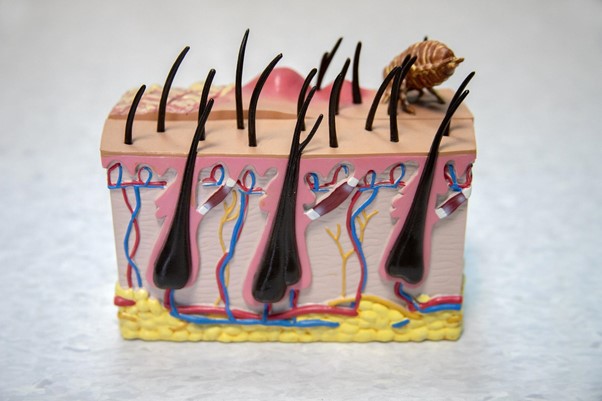Flea and Tick Prevention
- Last updated on April 17, 2023
- By: Caroline Stowe
Flea and tick prevention is a critical part of keeping your pet healthy. Fleas and ticks can cause discomfort, itching and skin irritation for your dog, as well as transmit dangerous diseases like Lyme disease.
Fortunately, there are several options available to help protect your pet from these pests. By using flea and tick-preventative products, you can keep your pet safe and healthy.

What are Fleas?
Canine fleas are small, wingless parasites that feed on the blood of dogs. They are a type of ectoparasite, meaning they live and feed on the outside of their host’s body.
Fleas have a flattened body shape and pointed heads, allowing them to easily move through fur and skin. Their size ranges between 1 to 4 mm, and they are brown-black in color. They can infest your pet and spread throughout the home or yard, so it’s important to take steps to prevent them.
Flea prevention is a key part of keeping your pet safe from uncomfortable flea bites and protecting them from the risk of diseases. Flea prevention products work by killing adult fleas or stopping their eggs from hatching. This can be achieved through a combination of topical treatments, collars, and oral medications.
What are Ticks
Canine ticks are external parasites that feed on the blood of a host animal, such as a dog or other canine species. These small arachnids can be difficult to detect, as they often attach themselves to the fur or skin, and then go unnoticed until they have fed.
While some ticks pose little threat beyond being an annoying pest, others can transmit serious diseases.
Tick prevention is an important part of keeping your pet safe from dangerous tick-borne diseases. There are several options available to help protect your pet from ticks, such as topical treatments and spot-on medications.
These products contain pesticides that not only kill adult ticks but also repel them, reducing the risk of tick bites.

Tips on How to Prevent Canine Fleas and Ticks
There are a few simple steps you can take to prevent fleas and ticks from taking up residence on your pup.
Keep Your Dog Well Groomed
Regular brushing helps remove any existing fleas or ticks and also prevents new ones from setting up shop.
Keep in mind, not to irritate the skin of your dog by brushing in the direction of hair growth.
If your dog has long hair, you may want to consider taking them to a professional groomer for regular haircuts.
Use Pet-Safe Flea & Tick Treatment
There are a variety of flea and tick treatment options available that are safe for use around dogs. Talk to your veterinarian about which products are right for your pet and be sure to follow the directions carefully.
Some flea and tick treatment is applied directly to the dry skin on your dog’s back between the shoulder blades. There are also oral flea treatment pills specially formulated for dogs.
Avoid Wooded Areas
Fleas and ticks love nothing more than a nice, wooded area to set up camp. If possible, avoid taking your dog for walks in heavily wooded areas or tall grasses.
If you must walk in these areas, be sure to check your dog for fleas and ticks afterward.
Keep Your Lawn Trimmed
Long grass is another prime spot for fleas and ticks to hide out. Keep your lawn trimmed short, especially in areas where your dog likes to spend time outside.
If you have taller grass or weeds in other parts of your yard, consider using a pet-safe herbicide to keep them under control.
Use Sand or Gravel in Play Areas
If your dog has a favorite spot in the yard where they like to play, consider covering it with sand or gravel instead of grass or mulch.
This will make it harder for fleas and ticks to hide and will make them easier to spot if they do manage to sneak onto your property.
Check Your Dog Regularly
Even if you take all of the necessary precautions, there’s always a chance that your dog could pick up a flea or tick somewhere along the way.
Be sure to check them regularly for any signs of parasites, such as excessive scratching or biting, hot spots, bald spots, or scabs on the skin. If you find anything suspicious, contact your veterinarian right away.
Bathe Your Dog Regularly
A good bath can do wonders for preventing fleas and ticks (not to mention make your pup smell nice).
Be sure to use a pet-safe shampoo that will kill any existing parasites while also repelling new ones.
For best results, bathe your dog once a week during peak flea and tick season (usually spring through fall).
Keep Your Home Clean
Fleas and ticks aren’t just found outside, they can also hitch a ride into your home on clothing or shoes and then set up shop in carpeting or furniture fabric.
To prevent this from happening, vacuum regularly and wash all bedding (including pet bedding) in hot water at least once a week during peak season.
You should also consider treating your home with an insecticide designed specifically for indoor use.

Give Your Dog Natural Supplements
There are several natural supplements available that can help repel fleas and ticks.
Many of these supplements contain ingredients like garlic, Vitamin B1, or brewer’s yeast, which are effective at deterring pests.
Talk to your veterinarian about which supplements might be right for your pet.
Make Sure Your Dog is Up-to-Date on Their Vaccinations
In addition to taking preventive measures against fleas and ticks, you must keep your dog up-to-date on their vaccinations.
Some diseases that these parasites can transmit, such as Lyme disease, can be prevented with routine vaccinations.
How To Check If Your Dog Has Fleas or Ticks?
Let’s take a look at what you should look out for.
Checking For Fleas and Ticks By Sight
The easiest way to tell whether your dog has fleas or ticks is by sight. Start by running your hands over the fur on your pup’s body, paying special attention to the stomach, neck, and tail area.
You’re looking for small black specks that move quickly – these are adult fleas.
You may also be able to see larger dark spots that don’t move – these are adult ticks. If you find any evidence of fleas or ticks on your pup’s body, it’s best to visit the vet right away so they can determine the best course of action.
Checking For Flea and Tick Bites
In addition to checking for fleas and ticks by sight, you should also keep an eye out for signs of bites around the fur on your dog’s body.
Flea bites typically appear as small red bumps in clusters near their legs and belly area while tick bites usually appear as large red circles with a dark center surrounded by reddish-pink rings.
If you think your pup may have been bitten by either a flea or tick, be sure to contact your veterinarian as soon as possible so they can properly diagnose the issue and provide treatment if necessary.
Using A Comb Or Brush To Check For Fleas and Ticks
Another way to check if your dog has fleas or ticks is by using a comb or brush specifically designed for this purpose.
This method is especially useful if you can’t find any evidence of flea or tick bites on their body or if you’re having trouble seeing any adult pests with the naked eye.
All you need to do is use a specialized comb/brush designed specifically for this purpose to help remove any dead skin cells and dirt from their fur while catching any potential pests in the process.
Be sure to dispose of the comb/brush afterward to prevent further contamination!
Benefits of Flea and Tick Prevention for Dogs
Following are some of the benefits of using flea and tick prevention products for dogs.
Protection from Disease
One of the most important reasons to prevent fleas and ticks on your dog is to protect them from diseases.
Fleas can carry and transmit deadly diseases like typhus, while ticks can transmit Lyme disease, Rocky Mountain spotted fever, ehrlichiosis, anaplasmosis, and more.
By keeping your dog free of fleas and ticks, you’re helping to protect them from these potentially fatal diseases.
Allergy Relief
If your dog is allergic to fleas or ticks, preventing these parasites is essential for their comfort.
Flea allergies can cause intense itching, hair loss, hot spots, and more.
Tick allergies are less common but can still cause problems like fever, anemia, lameness, and even paralysis.
Save Money in the Long Run
Treating a flea or tick infestation can be expensive, not to mention the cost of treating any resulting diseases.
The best way to avoid these costs is to prevent fleas and ticks from getting on your dog in the first place with the regular use of a quality preventive product.
Avoid Contaminating Your Home
Fleas don’t just live on animals—they also live in carpeting, bedding, furniture, and other places in your home.
If your dog has fleas, those fleas will eventually make their way into your home where they’ll lay eggs and continue the cycle.
To avoid infesting your home with fleas (and dealing with the ensuing headache), it’s best to prevent them from getting on your dog in the first place.
The same goes for ticks, the last thing you want is to find one crawling around in your bed!
Peace of Mind
When you know your dog is protected from fleas and ticks, you’ll have one less thing to worry about.
You’ll be able to enjoy time outdoors with your furry friend without having to constantly worry about parasites making themselves at home on their skin.

Easier Bath Time
If you’ve ever bathed your dog only to find that they’re still itchy afterward, you know how frustrating it can be trying to get rid of all those pesky fleas!
When you use a quality preventive product, you won’t have to worry about giving Flea Bath 2.0.
The process will be much simpler (and less frustrating for both you and your pup).
Healthier Skin and Coat
When parasites like fleas and ticks make themselves at home on your dog’s skin, they can cause irritation, inflammation, hair loss, hot spots, scabs, and more.
Not only is this uncomfortable for your pup—it can also lead to long-term damage if left untreated.
By preventing these parasites from taking up residence on your dog’s skin, you’re helping them maintain a healthy coat and avoiding potential health problems down the road.
Avoid Itchy Ears
Fleas aren’t just a nuisance—they can also cause serious health problems for dogs if they’re not removed promptly (and properly).
One common problem caused by fleas is Otitis externa (or inflammation of the outer ear), which can be extremely painful for dogs (not to mention difficult to treat).
To avoid this problem altogether, use a quality preventive product that will keep fleas away from their ears in the first place.
Greater Comfort During Groomings
No one likes getting their nails trimmed or their teeth brushed but it’s especially unpleasant when there are parasites involved!
If you regularly take your dog to the groomer (or do it yourself at home), you know how important it is to keep their skin free of pests before each appointment.
Not only will this help them stay calm during the grooming process, but it will also help avoid transferring any parasites from their skin onto yours (or anyone else’s).
Better Overall Health
When parasites like fleas or ticks make themselves at home on your dog’s skin or in their fur, it creates an ideal environment for bacteria to grow.
This bacteria can then enter your dog’s bloodstream through open wounds or bites, leading to serious health problems.
By preventing these parasites from setting up shop on your pup, you’re not just making their life more comfortable, you’re also helping them avoid potentially fatal infections.
Learn how to prevent fleas in dogs by clicking the link below.
What to Look for in a Quality Product
When it comes to flea and tick prevention, there are a lot of products on the market. How do you know which one is right for your dog?
Here are a few things to look for in a quality flea and tick prevention product.
Efficacy
The most important thing to look for in a flea and tick prevention product is efficacy. Does the product work? There are a lot of products on the market that claim to be effective but don’t live up to their claims.
Make sure to read reviews from other pet owners and do your research to ensure that the product you’re considering is effective at preventing fleas and ticks.
Safety
Another important consideration is safety. You want to make sure that the product you choose is safe for your dog to use.
Some products on the market contain harmful chemicals that can be dangerous for your dog if used incorrectly.
Always read the label carefully and follow the instructions to ensure you use the product safely.
Convenience
Nobody wants to spend hours applying a flea and tick prevention product to their dog. When considering different products, think about convenience.
Is the product easy to apply? Does it require frequent reapplication? The more convenient the product, the more likely you are to use it correctly and consistently, which is essential for preventing fleas and ticks.
Cost
Cost is always a consideration when purchasing any type of product, but it’s especially important when it comes to flea and tick prevention products because they often require frequent reapplication.
Look for a product that offers good value without compromising on quality or efficacy.
Environmental Impact
When choosing a flea and tick prevention product, it’s also important to consider the environmental impact of the product.
Some products contain harmful chemicals that can have negative impacts on the environment if they’re not used correctly.
If you’re concerned about the environment, look for a natural or organic option that will be safer for both your dog and the planet.
Tips on How to Apply the Product Correctly
Flea and tick prevention products are designed to protect your dog from fleas, ticks, and other pests that can cause them harm. When applied correctly, these products are safe and effective.
Following are some tips on how to apply the canine flea and tick prevention product correctly.
Read Label
Read the label carefully before using the product. This will ensure that you are using the product correctly and according to the manufacturer’s instructions.
Select Fur-Free Area
Choose an area on your dog’s body that is free of fur. This will help the product work more effectively.
Apply On Skin
Apply the product directly to the skin, not the fur. This will help to ensure that the product comes into contact with your dog’s skin, where it can be most effective.

Apply Generous Amount
Use only enough of the product to cover the area you are treating. Applying too much of the product can be ineffective and may even be harmful to your dog.
Avoid Contact With Sensitive Areas
Avoid contact with your dog’s eyes, nose, and mouth when applying the product. If any of the product gets into these areas, rinse them immediately with water.
Allow Applied Area To Dry
Allow the treated area to dry completely before letting your dog go outside or come into contact with other pets or people.
Reapply
Reapply the product as directed by the manufacturer’s instructions. This will help to ensure that your dog is protected against fleas and ticks for as long as possible.
Monitor
If you notice any adverse reactions in your dog after applying the product, such as redness, swelling, or excessive scratching, discontinue use immediately and consult your veterinarian for advice.
Store
Store the product in a cool, dry place out of reach of children and pets when not in use.
Follow Advised Precautions
Follow all other precautions on the label as directed by the manufacturer’s instructions.
Conclusion
Taking proper steps towards flea and tick prevention is essential in keeping your pup healthy all year round!
Ensuring they stay up-to-date on monthly preventives and regular check-ups during the peak season will help ensure that they remain happy and healthy while minimizing any risks associated with these pests.
Remember, if you ever have questions about protective measures please don’t hesitate to reach out to your vet!
They will be able to provide personalized advice based on the specific needs of you and your pup so that both of you can enjoy plenty of outdoor fun without having to worry about these pesky parasites!
-
Author: Caroline Stowe
- Updated on April 17, 2023
Disclaimer: This article doesn’t intend to replace professional veterinary advice, nor should it be used as a substitute for veterinary services, diagnosis, or treatment. The content on this website, including information and opinions expressed herein, are intended for general informational purposes only. In case you have concerns or questions regarding your dog’s health and diet requirements, please consult your veterinarian before doing anything that might affect it.
DogPetGuide.com and the writer are not responsible or liable for any damage, liability, costs, or claims arising from any possible consequences of the reader’s action after reading this article.




